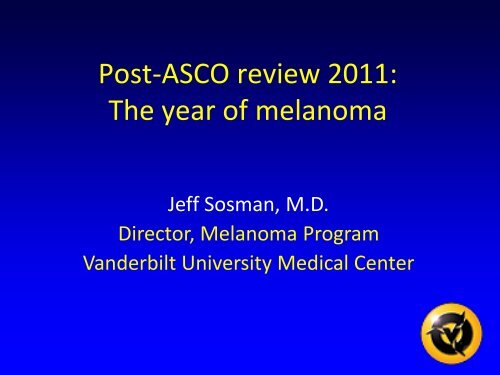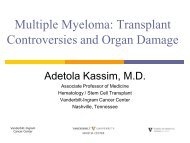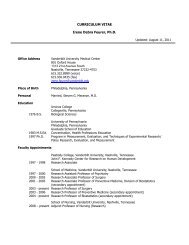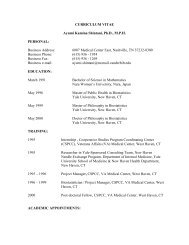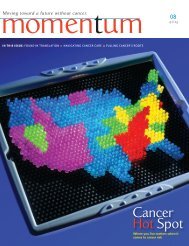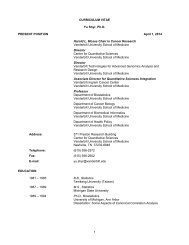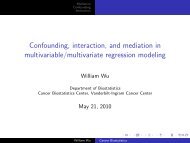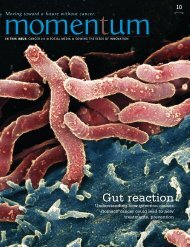Post-ASCO review 2011: The year of melanoma - Vanderbilt-Ingram ...
Post-ASCO review 2011: The year of melanoma - Vanderbilt-Ingram ...
Post-ASCO review 2011: The year of melanoma - Vanderbilt-Ingram ...
- No tags were found...
You also want an ePaper? Increase the reach of your titles
YUMPU automatically turns print PDFs into web optimized ePapers that Google loves.
<strong>Post</strong>-<strong>ASCO</strong> <strong>review</strong> <strong>2011</strong>:<strong>The</strong> <strong>year</strong> <strong>of</strong> <strong>melanoma</strong>Jeff Sosman, M.D.Director, Melanoma Program<strong>Vanderbilt</strong> University Medical Center
Disclosures• Consultant: H<strong>of</strong>fmann-La Roche,GlaxoSmithKline• Clinical Trial Support: H<strong>of</strong>fmann-La Roche,GlaxoSmithKline, Bristol Myers Squibb
Metastatic <strong>melanoma</strong>-historical experience• Rising incidence (Australia, Europe, USA)• Median age: 45-50 <strong>year</strong>s• Median OS: 6-10 months• 5 –<strong>year</strong> survival: < 5%• NO PROVEN OS BENEFIT FROM CHEMOTHERAPY or IL-2• Clinical trial <strong>of</strong> new therapy or combination- DTIC was “golden standard” , ORR 5-15 %, median duration <strong>of</strong>response 4-6 months, OS 6-10 months, approved 1973-15% responses,no randomized data- Combination chemo or biochemotherapy- improved RR no OSimprovement- High dose IL-2: 15% ORR, 5-8% CR (60% <strong>of</strong> CR> 5 <strong>year</strong>s=CURE)toxic, limited use due to cost, comorbidities <strong>of</strong> typical patient (FDAapproved 1998, durable responses, no randomized data)
Metastatic <strong>melanoma</strong>-breakthroughs <strong>2011</strong>• Ipilimumab approved by FDA in March <strong>2011</strong> for advanced <strong>melanoma</strong>based on OS benefit for pretreated patients, 3 mg/kg, 4 doses q 3 weeks,Yervoy• 2 plenary sessions at <strong>ASCO</strong> <strong>2011</strong>-both showing OS benefit• Ipilimimab for newly diagnosed metastatic patients• Vemurafenib (V-600-E-MU-tated-RAF-ENIB) for newly diagnosed patientswith V600E/K mutation in BRAF gene• Vemurafenib Phase II (BRIM 2)- 53%ORR, met primary endpoint• BRAF+MEK inhibitor (GSK436+GSK212) Phase I doseescalation/expansion-tolerated, able to combine full doses, highresponses, improved skin toxicity, need long term data, PFS, randomizedPhase II (RAF vs 2 dose levels MEK+RAF under way)• BRAF skin toxicity-development <strong>of</strong> KA/cSCC, majority carry HRAS (orNRAS) preexisting mutation) Lacouture et al.
New <strong>melanoma</strong> therapies: <strong>2011</strong>• Immunotherapy/monoclonal antibodies– anti CTLA-4/ipilimumab/Yervoy #LBA5 Wolchok, J. et al.– Ipilimimab+bevacizumab, #8511 Hodi, S. et al. Phase I-tolerated, signal <strong>of</strong> efficacy• Targeted therapy for <strong>melanoma</strong> with BRAFmutations (V600E/K/others)– VEMURAFENIB (PLX4032) #LBA4 Chapman, P. et al.– BRIM2 Vemurafenib #8509 Ribas, A. et al.– GSK 436+ GSK212 (BRAF+MEK)#CRA8503 Infante, J. et al.
Ipilimumab, a CTLA-4 Blocking MonoclonalAntibody, Augments T-Cell ActivationT-cellActivationT-cellInactivationT-cell RemainsActiverestingT-cellCTLA-4T-cellT-cellTCRCD28CTLA-4CTLA-4HLAB7IpilimumabAPCAPCAPCKorman, Peggs and Allison: Adv. In Immunol. 2006;90:297-339 4
A phase III, randomized, double-blind, multicenter studycomparing monotherapy with ipilimumab or gp100 peptide vaccineand the combination in patients with previously treated,unresectable stage III or IV <strong>melanoma</strong>Steven O’Day 1 , F. Stephen Hodi 2 , David McDermott 3 , Robert Weber 4 ,Jeffrey Sosman 5 , John Haanen 6 , Xiaoping Zhu 7 , Michael Yellin 7 , AxelHoos 8 , Walter J. Urba 91<strong>The</strong> Angeles Clinic and Research Institute, Santa Monica, CA; 2 Dana-Farber Cancer Institute, Boston,MA; 3 Beth Israel Deaconess Medical Center, Boston, MA, 4 Saint Mary's Medical Center, San Francisco,CA; 5 <strong>Vanderbilt</strong>-<strong>Ingram</strong> Cancer Center, Nashville, TN; 6 <strong>The</strong> Netherlands Cancer Institute, Amsterdam,<strong>The</strong> Netherlands; 7 Medarex Inc., Bloomsbury, NJ; 8 Bristol-Myers Squibb Co., Wallingford, CT; 9 Earle A.Chiles Research Institute, Portland, OR
Study DesignPre-treatedMetastaticMelanoma(N=676)RANDOMIZEIpilimumab + gp100Ipilimumab + placebogp100 + placebo(N=403)(N=137)(N=136)8
Ipilimumab alone ImprovesOverall Survival Compared to gp100Ipi + pbo gp100 + pbo P-valueSecondary ComparisonN 137 136Number <strong>of</strong> deaths 100 119Hazard ratio(95% CI)Median OS,Month (95% CI)0.66 (0.51,0.87)10.1 6.4(8.0,13.8) (5.5, 8.7)0.00269
Study 020,2 nd or later line therapy , <strong>ASCO</strong> 2010Ipilimumab survival data1 <strong>year</strong> 43%2 <strong>year</strong>s 24%3 <strong>year</strong>s 20%Ipi + gp100Ipi alonegp100 aloneComparison HR p-valueArms gp100 vs Ipi 0.68 0.004Hodi et al, NEJM 20101 2 3 4
Phase 3 randomized study <strong>of</strong> ipilimumab (IPI)plus dacarbazine (DTIC) vs DTIC alone as firstline treatment in patients with unresectablestage III or IV <strong>melanoma</strong> (LBA5)Jedd Wolchok 1 , Luc Thomas 2 , Igor Bondarenko 3 , Steven O’Day 4 ,Jeffrey Weber 5 , Claus Garbe 6 , Stephen Francis 7 , Ramy Ibrahim 8 ,Axel Hoos 8 , Caroline Robert 91Memorial Sloan-Kettering Cancer Center, New York, NY; 2 Lyon 1 University Centre Hospitalier LyonSud, Pierre Benite, France; 3 City Clinical Hospital, Dnepropetrovsk, Ukraine; 4 <strong>The</strong> Angeles Clinic &Research Institute, Los Angeles, CA; 5 M<strong>of</strong>fitt Cancer Center, Tampa, FL; 6 University <strong>of</strong> Tübingen,Tübingen, Germany; 7 Bristol-Myers Squibb, Brainel'Alleud, Belgium; 8 Bristol-Myers Squibb,Wallingford, CT; 9 Institut Gustave Roussy, Villejuif, France
DesignScreeningINDUCTION MAINTENANCE *PreviouslyUntreatedMetastaticMelanoma(N=502)RR= blindedrandomization(1:1)Week 1Ipilimumab 10 mg/kgQ3W X4Dacarbazine 850 mg/m 2Q3W x8PlaceboQ3W X4Dacarbazine 850 mg/m 2Q3W x8Week 12 Week 24Ipilimumab 10 mg/kgQ12WPlaceboQ12W* in absence <strong>of</strong>progression ordose-limiting toxicityBaselineTumor AssessmentFirst ScheduledTumor AssessmentSTATISTICAL DESIGN: primaryendpoint changed to OS12
Pr opor t i onAl i veOverall Survival1. 00. 90. 80. 70. 60. 50. 40. 30. 20. 10. 0Ipilimumab + DTICPlacebo + DTICIpilimumab + DTIC versus Placebo + DTICHR (95% CI) 0.72 (0.59–0.87)Median OS11.2 vs 9.1 monthsP value 0.00090 1 2 3 4Year s13
Pr opor t i onAl i veOverall Survival-landmark analysis1. 00. 90. 80. 70. 60. 50. 40. 30. 20. 10. 00 1 2 3 4Year sEstimatedSurvival Rate 1 Year 2 Year 3 Year*Ipilimumab + DTICn=250Placebo + DTICn=25247.3 28.5 20.836.3 17.9 12.2Ipilimumab + DTICPlacebo + DTIC*3-<strong>year</strong> survival was a post-hoc analysis14
Pr opor t i on Not Pr ogr essedStudy 024: Progression-Free Survival1. 00. 90. 80. 70. 60. 50. 40. 30. 20. 10. 0Ipilimumab + DTICPlacebo + DTICIpilimumab + DTIC versus Placebo + DTICHR (95% CI) 0.76 (0.63–0.93)Median PFS2.8 vs 2.6 monthsP value 0.0060 1 21 st tumor assessmentYear s(per protocol)15
Study 024: Tumor ResponseIpilimumab +DTICn=250Placebo +DTICn=252Disease Control Rate, n (%) 83 (33.2) 76 (30.2)BORR (CR + PR), n (%) 38 (15.2) 26 (10.3)Complete response 4 (1.6) 2 (0.8)Partial response 34 (13.6) 24 (9.5)Stable disease 45 (18.0) 50 (19.8)Progressive disease 111 (44.4) 131 (52.0)Duration <strong>of</strong> response,monthsBORR=Best Overall Response RatePatients (%) not evaluable for response (no follow-up scans): 56 (22.4) vs 45 (17.9)19.3 8.116
Select Adverse EventsIpilimumab + DTICn=247Placebo + DTICn=251Total Grade 3-4 Total Grade 3-4% PatientsHepaticIncreased ALT 33.2 21.9 5.6 0.8Increased AST 29.1 18.2 5.6 1.2EndocrineHypothyroidism 1.6 0 0.4 0Thyroiditis 0.8 0 0 0Hyperthyroidism 0.4 0 0.4 0Hypophysitis* 0 0 0 0*1 (0.4%) hypophysitis in a patient on maintenance was reported on Day 364Select adverse events are shown, regardless <strong>of</strong> attribution17
Conclusions● Second randomized ipilimumab phase III trial to showsignificant survival improvement in metastatic<strong>melanoma</strong>● No benefit from DTIC and more liver toxicity withdecreased ipilimumab exposure by 25%● Do not use DTIC+ipilimumab, use ipilimumab alone● What dose <strong>of</strong> Ipilimumab 3 or 10mgkg?● Role <strong>of</strong> maintenance Ipilimumab18
New <strong>melanoma</strong> therapies: <strong>2011</strong>• Immunotherapy/monoclonal antibodies– anti CTLA-4/ipilimumab/Yervoy #LBA5 Wolchok, J. et al.– Ipilimimab+bevacizumab, #8511 Hodi, S. et al.• Targeted therapy for <strong>melanoma</strong> with BRAFmutations (V600E/K/others)– VEMURAFENIB (PLX4032) #LBA4 Chapman, P. et al.– BRIM2 Vemurafenib #8509 Ribas, A. et al.– GSK 436+ GSK212 (BRAF+MEK)#CRA8503 Infante, J. et al.
Molecular alterations in Melanoma
Inhibition <strong>of</strong> BRAF V600E To ArrestAbnormal Cell Growth• ~ 8% <strong>of</strong> all solid tumors (thyroid, CRC, lung,breast, ovary, prostate, HCL, med GC,cholangio)Membrane• ~ 50% <strong>of</strong> malignant <strong>melanoma</strong>sOncogenicsignalingB-Raf V600EV600E InhibitorPPMEKERKRationale:Specificinhibitoragainst V600EshouldsuppressoncogenicsignalingAbnormal CellularProliferationArrested
%Change From Baseline(Sum <strong>of</strong> Lesion Size)Phase I Trial:• Tumor responses occurredin majority (81%, 59%confirmed) <strong>of</strong> patients inV600E+ <strong>melanoma</strong>extension cohort (960 mgBID)• V600K-2 pts (1 PR, 1 CR)• PFS 7.6 months (vs. 1.8months wt)• Brain metastases excluded1007550250-25-50-75-100• Investigator assessments• Includes confirmed & unconfirmed responses22
An Open-Label, Multicenter Phase II Study <strong>of</strong>Continuous Oral Dosing <strong>of</strong> RG7204 (PLX4032) inPreviously Treated Patients with BRAF V600EMutation-Positive Metastatic MelanomaA Ribas, 13 K Kim, 2 L Schuchter, 3 R Gonzalez, 4 A Pavlick, 5 J Weber, 6G McArthur, 7 T Hutson, 8 D Lawrence, 9 S Moschos, 10 K Flaherty, 9 P Hersey, 11R Kefford, 12 B Chmielowski, 13 R Amaravadi, 3 I Puzanov, 1 J Li, 14S Bhattacharya, 15 K Nolop, 16 R Lee, 14 A Joe, 14 J Sosman 11<strong>Vanderbilt</strong> University, Nashville, TN; M.D. Anderson Cancer Center, Houston, TX; 3 University <strong>of</strong>Pennsylvania, Philadelphia, PA; 4 University <strong>of</strong> Colorado, Denver, CO; 5 New York University Medical Center,New York, NY; 6 M<strong>of</strong>fitt Cancer Center, Tampa, FL; 7 Peter MacCallum Cancer Centre, East Melbourne, AUS;8Texas Oncology-Baylor Cancer Center, Dallas, TX; 9 Massachusetts General Hospital Cancer Center,Boston, MA; 10 University <strong>of</strong> Pittsburgh, Pittsburgh, PA; 11 University <strong>of</strong> Newcastle, Newcastle, AUS;12Westmeade Hospital, NSW, AUS; 13 University <strong>of</strong> California, Los Angeles, Los Angeles, CA; 14 H<strong>of</strong>fmann-LaRoche, Nutley, NJ; 15 Genentech, South San Francisco, CA; 16 Plexxikon Inc., Berkeley, CA
BRIM-2 Study DesignMetastatic MelanomaPrior TreatmentV600E+(n=132)RG7204(960 mg BID)Endpoints:Primary: ORR (IRC)Secondary: duration <strong>of</strong> response,PFS, OS, and safetyEligibility Criteria• PD after prior IL-2 or standard chemotherapy (DTIC, TMZ, C/T, fotemustine)• PS=0 or 1• Brain metastases allowed if treatment with stereotactic RT or surgery,and stable for >3 moStatistical Considerations• Target BORR is 30%• 10% patients considered unevaluable• Total <strong>of</strong> 90 patients required to demonstrate the lower boundary <strong>of</strong> the exact95% CI is at least 20%24
Tumor Responses Assessed by IRC• ORR 52% by IRC* Primary endpoint met• ORR 55% by investigator assessments (INV)• RR, including unconfirmed, 68% (INV)• Response duration 7 months, PFS 6.8 months*6 patients were unevaluable 25
Phase III randomized, open-label, multicentertrial (BRIM3) comparing BRAF inhibitorvemurafenib with dacarbazine in patients withBRAF V600E -mutated <strong>melanoma</strong> (Abstract #LBA4)P. Chapman, A. Hauschild, C. Robert, J. Larkin, J. Haanen, A.Ribas, D Hogg, S. O'Day, P. Ascierto, A. Testori, P. Lorigan, R.Dummer, J. Sosman, C. Garbe, R. Lee, K. Nolop, B. Nelson, J.Hou, K. Flaherty, G. McArthurChapman et al., NEJM June <strong>2011</strong>
Phase III BRIM3 Study designScreeningBRAF V600E mutationStratification• Stage• ECOG PS (0 vs 1)• LDH level (↑ vs nl)• Geographic regionRandomizationN=675Vemurafenib960 mg po bid(N=337)Dacarbazine1000 mg/m 2 iv q3w(N=338)STATISTICAL DESIGN: HR 0.65 for OS-primary endpoint, HR 0.55 for PFS
No. <strong>of</strong> patients accruedBRIM 3 timeline-fastest positive Phase III trialon record in oncologyRevisedstatisticalplanLastpatientenrolledDSMBInterimanalysisInterimanalysisdata cut-<strong>of</strong>f2010 <strong>2011</strong>
Patient characteristicsDacarbazine(N=338)Vemurafenib(N=337)Median age, yr 52.5 56.0Male, no. (%) 181 (54) 200 (59)ECOG PS , no. (%):0 230 (68) 229 (68)1 108 (32) 108 (32)Stage, no. (%)Unresectable IIIc 13 (4) 20 (6)M1a 40 (12) 34 (10)M1b 65 (19) 62 (18)M1c 220 (65) 221 (66)LDH >ULN 142 (42) 142 (42)
Overall survival (%)1009080706050403020100No. <strong>of</strong> patients in follow upDacarbazineVemurafenibOverall survival (Dec 30, 2010 cut<strong>of</strong>f)Vemurafenib (N=336)Est 6 mo survival 84%0 1 2 3 4 5 6 7 8 9 10 11 12Months336336283320Dacarbazine (N=336)Est 6 mo survival 64%Hazard ratio 0.37(95% CI; 0.26 - 0.55)Log-rank P
Overall Survival (%)Overall survival BRIM-2 and BRIM-310090BRIM3 Vemurafenib8070605040302010BRIM3 DacarbazineBRIM2 Vemurafenib00 1 2 3 4 5 6 7 8 9 10 11 12MonthsBRIM3Dacarbazine 336 283 192 137 98 64 39 20 9 1 1Vemurafenib 336 320 266 210 162 111 80 35 14 6 1At riskBRIM2Vemurafenib132 131 128 122 118 109 97 90 83 78 71 55 34 19 7
BRIM3: OS by baseline characteristicFactorNumber<strong>of</strong> patientsFavorsvemurafenibFavorsdacarbazineAll patients 672Age:Sex:ECOG status: 01
Progression-free survival (%)1009080706050403020100No. <strong>of</strong> patients in follow upDacarbazineVemurafenibProgression-free survival (Dec 30, 2010Hazard Ratio 0.26(95% CI; 0.20 - 0.33)Log-rank P
Objective response rates (RECIST 1.1)CRPROverall responserateVemurafenib 0.9% 47.5% 48.4%Dacarbazine 0 5.5% 5.5%
Percent change from baseline in sum <strong>of</strong> tumor diametersMaximal tumor shrinkage by individual patient>10050Vemurafenib0-50-100>100Dacarbazine500-50-100
Selected adverse events (% <strong>of</strong> patients)Vemurafenib, n= 336 Dacarbazine, n= 282Adverse events All Grade 3 Grade≥ 4 All Grade 3 Grade ≥4Arthralgia 49 3 - 3
Cutaneous SCC – Keratoacanthoma (KA) Subtype #8520Lacouture et al.Characteristics <strong>of</strong> KA subtype• Raised button-like, central crater• Well-differentiated neoplasm with low probability <strong>of</strong>invasion/metastasis• Can grow rapidly; may involute and regress• Typically treated by excision• Did not result in treatment discontinuation• Observed with RAF inhibitors(e.g., sorafenib)• Occurred on sun-exposed skin• Association with HRAS (15/18) and NRAS (1/18) mutation in skin(higher then sporadic (6/53)37
Conclusions• Vemurafenib associated with 63% decrease in hazard <strong>of</strong>death at 6 months (p
Time line <strong>of</strong> PLX4032/Vemurafenib developmentVemurafenib is approved by FDABRIM3 presented at <strong>ASCO</strong> (Chapman)
Phase I/II Study <strong>of</strong> the Oral MEK 1/2 InhibitorGSK1120212 Dosed in Combination with theOral BRAF Inhibitor GSK2118436 (#CRA8503)Jeffrey Infante 1 , Gerald Falchook 2 , Donald Lawrence 3 , Jeff Weber 4 , Richard Kefford 5 ,Johanna Bendell 1 , Razelle Kurzrock 2 , Ge<strong>of</strong>frey Shapiro 3 , Ragini Kudchadkar 4 ,Georgina Long 5 , Howard Burris 1 , Kevin Kim 2 , Arthur Clements 5 , Peng Sun 6 , BingmingYi 6 , Alicia Allred 6 , Daniele Ouellet 6 , Kiran Patel 6 , Peter Lebowitz 6 , Keith Flaherty 31Sarah Cannon Research Institute, Nashville, TN, USA; 2 MD Anderson Cancer Center,Houston, TX, USA; 3 MGH/DFCI, Boston, MA, USA; 4 M<strong>of</strong>fitt Cancer Center, Tampa, FL,USA; 5 Melanoma Institute <strong>of</strong> Australia and Westmead Hospital, University <strong>of</strong> Sydney,Australia; 6 GlaxoSmithKline Research and Development, Philadelphia, PA and RTP, NC,USA
MEKi Blocks BRAFi-InducedHyper-proliferative Skin Lesions in RatsControl BRAFi (150 mg/kg) BRAFi + MEKi (1.5 mg/kg)BRAFi alone results inthickening &hyperkeratosisCo-dosing with MEKiattenuates lesionformationCompounds investigated in preclinical studies are tool compoundsGSK unpublished dataAll animal work was approved by GSK Animal Care and Use Committee
Study Design and ObjectivesPart ADrug-DrugInteractionObjective:- Determine the effect <strong>of</strong> MEKi (GSK212)on BRAFi (GSK436) PKPart BDose EscalationExpansion CohortsObjectives:-Assess safety/tolerability-Determine recommended Phase 2 dose-Characterize steady-state PK-Evaluate clinical activityBackfill into previousescalation dosesPrior BRAFinhibitorColorectal BRAF+Part CRandomized Phase 2 trial
Maximum % reduction from baseline measurementWaterfall Plot for Melanoma Patientswithout Prior BRAFi (n=71)604020GSK436 75 mg BID/GSK212 1 mg QDGSK436 150 mg BID/GSK212 1 mg QDGSK436 150 mg BID/GSK212 1.5 mg QDGSK436 150 mg BID/GSK212 2 mg QD0-20-40-60-80-1005 CR: 3 confirmed, 2 waiting follow-up4 pts not shown on plot: 2 PR, 1 SD, 1 PD
Key Treatment-Related Skin ToxicitiesCombinationBRAFi (GSK436) + MEKi (GSK212)n=109 1Grade ≥ 3,n (%)Any grade event,n (%)Rash 2 2 (2%) 27 (25%)Skin papilloma 0 1 (
Tumor Molecular Pr<strong>of</strong>iling Results:One Size Does Not Fit AllJuly 1, 2010 - June 30, <strong>2011</strong>Melanoma Panel: 368 SamplesCindy Vnencak-Jones7 Double MutantsNRAS-G13R/CTNNB1-S45PBRAF-V600E/CTNNB1-S45PNRAS-Q61L/CTNNB1-S45PBRAF-V600K/CTNNB1-S45FNRAS-G12C/KIT-K642EBRAF-V600E/CTNNB1-S37CBRAF V600E/NRAS-Q61R
Analysis <strong>of</strong> First 150 Patients: 20% <strong>of</strong> BRAF V600 Mutations Would BeMissed by Allele-Specific PCRLovly, Dahlman, Fohn, Su et al, submitted
Melanoma therapy standards <strong>2011</strong>SettingPhase IIIPatient with sx, bulky disease,or Increased LDHVemurafenibFirst line-Genotype for at leastBRAF (Cobas TM orSanger sequencing)and c-kit mutationsAlso NRAS,GNA11,GNAQ-uveal*Phase III data availableBRAF mutatedC-kitBRAF wt or NRASIndolent disease-asx, M1a/M1b, asxVemurafenig or IpilimumabHD IL-2 first lineTrial options:BRAFi+MEKiBRAFi + IpilimumabClinical trials with nilotinib,sunitinib or imatinibAlternative ipilimumab* orHDIL-2HD IL-2 then Ipilimumab*Clinical trialsChemotherapy??
Brain metastasesOverall survival for 51-patient cohortRx w/ 10 mg/kg x 4 + maintenance~26% 2 yr OS estimate also seen in165-pt cohort from expanded access trialKevin Heller, BMS—data presented in part at ESMO 2009, <strong>ASCO</strong> 2010, <strong>2011</strong> posters
Metastatic <strong>melanoma</strong>- challenges• Ipilimumab (+other immunotherapy)- how to increase proportion <strong>of</strong>responders? Adjuvant? Dose selection/maintenance?• Vemurafenib (other RAF inhibitors)-how to battle resistance?Personalized therapy on progression? Adjuvant?• Development <strong>of</strong> combinations:– Targeted-RAF/MEK (#CRA8503 Infante et al.), RAF/AKT or PI3Kor IGFR/PDGF– Immunotherapies-ipi+IL-2, ipi+antiPD1, HD IL-2???– Targeted+immuno-vemurafenib+ipilimumab, RAF/MEK+antiPD1– Immunotherapy+antiangiogenic-bev+ipi #8511 Hodi,S et al., E7080(VEGF, FGFR)+vemuarfenib preclinical #8527• BRAF WT/NRAS mutated/uveal- cmet/VEGF? (XL184, #3010, Gordon etal., ARQ197+sorafenib #3087 Adjei, A et al.)-few responses, too early totell
Acknowledgements• Research staff including nurses, clinical research associates, regulatorypersonnel• Vemurafenib/PLX4032 Phase I lead investigators Keith Flaherty(MGH/Upenn) and Paul Chapman (MSKCC), principal investigators KevinKim (MDA), Antoni Ribas (UCLA), Grant McArthur (Peter MacCallum,Melbourne), Phase I lead investigator Igor Puzanov (<strong>Vanderbilt</strong>, Nashville)• GSK2118436/212 Phase I investigators Richard Kefford (Sydney), StevenO’Day (Angeles Clinic), H-T. Arkenau (Sydney), M. Brown (Adelaide), M.Millward (Perth), J. Infante (S. Cannon Res. Inst. Nashville), GeraldFalchook (MDA)• Developers at Plexxikon (Peter Hirth, Gideon Bollag, Keith Nolop), Roche(Richard Lee, Joseph Grippo) and GlaxoSmithKline (Peter Lebowitz, JeffLegos, Mary Guckert, Vicki Goodman)• Technical Development Team at H<strong>of</strong>fmann-La Roche led by Linda Rubia thatreformulated PLX4032 to give rise to vemurafenib• Toni Ribas, Paul Chapman, Jedd Wolchok, Kim Margolin, Jeff Infante forgenerously sharing slides51


